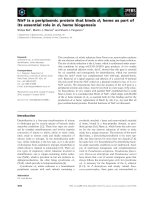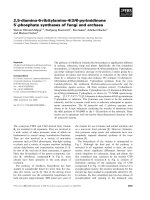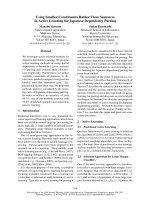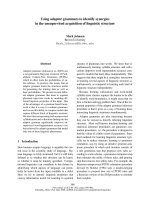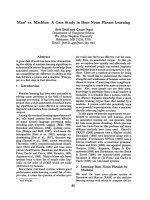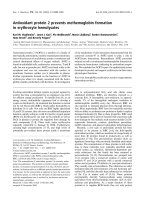Báo cáo khoa học: "HIV-1 CRF 02 AG polymerase genes in Southern Ghana are mosaics of different 02 AG strains and the protease gene cannot infer subtypes" doc
Bạn đang xem bản rút gọn của tài liệu. Xem và tải ngay bản đầy đủ của tài liệu tại đây (303.96 KB, 6 trang )
BioMed Central
Page 1 of 6
(page number not for citation purposes)
Virology Journal
Open Access
Research
HIV-1 CRF 02 AG polymerase genes in Southern Ghana are mosaics
of different 02 AG strains and the protease gene cannot infer
subtypes
Kwamena W Sagoe*
1
, Magda Dwidar
2
, Theophilus K Adiku
1
and
Max Q Arens
2
Address:
1
Clinical Virology Laboratory, Department of Microbiology, University of Ghana Medical School, PO Box 4236, Accra, Ghana and
2
Retrovirus Laboratory, Department of Pediatrics, Washington University Medical School, St Louis, Missouri 63110, USA
Email: Kwamena W Sagoe* - ; Magda Dwidar - ; Theophilus K Adiku - ;
Max Q Arens -
* Corresponding author
Abstract
Background: Little is known about the detailed phylogeny relationships of CRF 02_AG HIV-1
polymerase genes in Ghana. The use of the protease gene of HIV-1 for subtyping has shown
conflicting results.
Methods: The partial polymerase gene sequences of 25 HIV-1 strains obtained with Viroseq
reagents were aligned with reference subtypes and alignments trimmed to a 300 bp protease, 661
bp and 1005 reverse transcriptase sequence alignments. Phylogenetic relationships of these
alignments were determined with the Neighbour-Joining method using 1000 replicates and
recombination patterns determined for the sequences with RIP 3.0 in the HIV sequence database.
Results: Unlike the other alignments, the protease gene had nodes with bootstrap values < 100%
for repeat control sequences. Majority of the CRF 02_AG sequences from Ghana were made up
of fragments of several strains of CRF 02_AG/AG strains. The protease gene alone is not suitable
for phylogenetic analysis.
Conclusion: The polymerase genes of HIV-1 strains from Ghana are made up of recombinants of
several CRF 02_AG strains from Ghana, Senegal and Cameroon, but the clinical implications are
unknown. Using the HIV-1 protease gene for subtyping will not infer subtypes correctly.
Introduction
HIV-1 strains can be divided into three genetic groups (M,
N and O) with the group M further divided into 9 pure
subtypes [1-3]. Recombination has however led to the cir-
culation of mosaic HIV-1 strains, and these include the
circulation of circulating recombinant forms (CRF) which
play an important role in the epidemic [4-9].
Several studies have used the polymerase (pol), protease
(prot.), and reverse transcriptase (RT) genes for phylogeny
[9-19]. Also, the pol gene has been shown to be useful for
subtyping in areas with multiple subtypes [17]. In settings
where the CRF 02_AG is found, fragments of the RT gene
have been shown to provide a useful method for HIV-1
subtyping [9,12,14,15,17,18]. However, there are con-
Published: 26 February 2009
Virology Journal 2009, 6:27 doi:10.1186/1743-422X-6-27
Received: 23 December 2008
Accepted: 26 February 2009
This article is available from: />© 2009 Sagoe et al; licensee BioMed Central Ltd.
This is an Open Access article distributed under the terms of the Creative Commons Attribution License ( />),
which permits unrestricted use, distribution, and reproduction in any medium, provided the original work is properly cited.
Virology Journal 2009, 6:27 />Page 2 of 6
(page number not for citation purposes)
flicting reports on the usefulness of the prot. gene for sub-
type classification [12,14,15,18].
In Ghana, the predominant subtype for the prot. gene is
most likely to be CRF 02 AG [14]. Furthermore, it has
recently been shown with HIV-1 envelope-glycoprotein
gene (env-gp41) and pol sequences that most HIV-1 strains
do not have strong phylogenetic relationships with each
other [20,21], suggesting an extremely variable relation-
ship between strains. Since the role of subtypes and
recombinants in primary resistance to antiretroviral drugs
is still evolving and therefore unclear, subtyping of all
HIV-1 strains will be needed with resistance testing for
patients failing therapy in countries with non-subtype B
strains. With the scale-up of antiretroviral therapy in
Ghana, there is an increased need to perform resistance
testing for patients adhering to treatment, but still have
elevated viral loads despite prolonged therapy. Since com-
mercial kits like the ABI/Celera ViroSeq reagents (Celera
Diagnostics, Foster City, CA) are expensive for drug resist-
ance testing [11], the likelihood is that in-house assays
will be developed for the prot. and partial RT regions and
these fragments will also be used for subtype classifica-
tion.
This study therefore determined the suitability of using
the prot. and partial RT gene fragments of CRF 02_AG/AG-
like sequences from Ghana which could be used for drug
resistance testing, for subtype classification. The purity of
the HIV-1 strains with respect to CRF 02_AG/AG-like
strains involved in recombination were also looked at.
Methods
Sequencing of polymerase gene
Sequences from 25 patients infected with HIV-1 who
attended the Fevers Unit at the Korle-Bu Teaching Hospi-
tal in Accra, Ghana, in 2003 were used for this study. The
drug resistance mutations have been published recently
[21]. Polymerase (pol) gene sequences were obtained
using the ABI/Celera ViroSeq reagents (Celera Diagnos-
tics, Foster City, CA) and this has been described else-
where [11]. The nucleotide sequence data have been
submitted to the NCBI database [GenBank: EF174555
to
EF174569
and EF550529 to EF550538].
Phylogenetic analysis
Sequence homology of the 25 sequences (GHN
sequences) was done with the HIV Blast Search in the HIV
sequence database />db/BASIC_BLAST/basic_blast.html with a pair wise com-
parison. The sequences with the highest homology (n =
13) to the GHN sequences were aligned with HIV-1 refer-
ence subtypes and the 25 sequences obtained from Ghana
using the Clustal W software in BioEdit version 5.0.6 ftp:/
/iubio.bio.indiana.edu/molbio/seqpup/.
Two of the sequences obtained from the Blast Search CRF
02_AG from Cameroon (MP569 [GenBank: AM279387
])
and a subtype G from Nigeria (NG083 [GenBank:
U88826
]) were confirmed as already in the reference sub-
types by a conservation plot using BioEdit. They were
however included as internal controls (repeat sequences)
for phylogeny. From this original alignment which was
1305 bp long (pol.), three additional files were created by
trimming sequences so as to obtain alignments with dif-
ferent base lengths: 300 bp prot., 661 bp RT (RTs) and
1005 RT. The four alignments were exported in the Raw
Text format to the PHYLIP software v3.66 http://evolu
tion.genetics.washington.edu/phylip.html and used for
tree building. The RTs sequence includes amino acids 30
to 227 of the RT gene [22], and contains all the important
drug resistance mutations for individual HIV-1 drugs cur-
rently being used in Ghana.
Distance estimations were done using Dnadist with the
Kimura 2-parameter model [23], with the transition-to-
transversion (T/S) ratios that built the best possible phyl-
ogenetic tree. The Neighbor-joining analysis was then
used to create phylogenetic trees with 1000 datasets and
trees rooted with an HIV-1 group O strain (MVP5180
[GenBank: L20571
]). In order to build robust trees, Seq-
Boot was used to build 1000 replicates before distances
were estimated. The T/S ratio was determined by using the
Dnaml.exe file in the PHYLIP software to determine the
maximum likelihood of obtaining the best tree. For each
alignment (pol, prot., RTs, and RT), the likelihood of hav-
ing the best tree was determined by running the
Dnaml.exe with a T/S ratio from 1 to 4 with incremental
differences of 0.05. Since trees were going to be rooted
with HIV-1 group O as an out-group, the MVP5180 strain
was used as an out-group in Dnaml.exe for the T/S analy-
sis. A consensus tree was built with Consense after Neigh-
bor-joining and rooted with the MVP5180. Phylogenetic
trees were displayed with the Molecular Evolutionary
Genetics Analysis (MEGA) software version 4.0. Bootstrap
values of 70% were considered as being phylogenetically
significant.
Recombination and CRF02_AG out-groups
Recombination analysis was done with RIP 3 in the HIV
sequence database />db/RIP3/RIP.html with the 13 sequences obtained from
the Blast Search as a background sequence alignment.
After input of query sequences, the RIP 3 output was rerun
to identify fragments of the GHN sequences which had
high homologies to the sequences in the background
sequence alignment. The window size for the analysis was
set at 500 nucleotides because subtype inference for CRF
02_AG strains from Ghana have been done with a similar
length of nucleotides [6]. The significant threshold for the
RIP program was set at 90%.
Virology Journal 2009, 6:27 />Page 3 of 6
(page number not for citation purposes)
Of the 25 GHN sequences, 22 were CRF 02_AG and 2
were unclassified. These 24 sequences were also aligned in
a separate file and the T/S ratio for the best tree deter-
mined as described earlier. No out-group in Dnaml.exe
was chosen for this T/S analysis and bootstrapping (1000
replicates) and Neighbor-Joining were used to infer phyl-
ogenetic relationships between the sequences. Trees were
not rooted in Neigbor.exe (PHYLIP) and each sequence
was subsequently used as an out-group and bootstrap val-
ues inferred in TreeView l
ogy.gla.ac.uk/rod/treeview.html after a consensus tree was
built with Consense.
Results
Phylogenetic relationships
The T/S values for the likelihood of the best phylogenetic
tree differed for each group of sequences analyzed. For the
pol, prot, RT, and RTs, the values were 3.00, 1.85, 3.10 and
3.25 respectively. The file with the Ghana pol strains only
had a T/S of 3.05.
For the pol. and RT, GHN CRF 02_AG sequences were
inferred with sufficient confidence (≥ 70%), but the RTs
and prot. had bootstrap values of 57% and 22% respec-
tively. Sequences which were repeated had 100% boot-
strap values at their nodes for the pol., RT, and RTs, but not
the prot. Although the CRF 02_AG from Cameroon [Gen-
Bank: AM279387
] and one of the reference subtypes
[GenBank: AJ286937
] were shown to have the same
nucleotide sequences, the node for the two sequences had
bootstrap value of 59% for the prot. alignment (Figure 1a).
The subtype G from Nigeria [GenBank: U88826
] that was
repeated in the sequence alignment as U88826_R had
bootstrap value of 67% for the prot. alignment (Figure 1a).
The bootstrap values for the CRF 02_AG strains were 70%
for RT and 57% for RTs, but their tree topologies were
similar.
Recombination patterns/Out-groups
Apart from GHN60, which was a subtype G, and GHN36
that was closely related to a CRF02_AG sequence from
Ghana [GenBank: AB286862
], all the GHN sequences
were recombinants of various CRF 02_AG/AG-like strains
from Ghana, Cameroon and Senegal [see Additional file
1]. One of the two unclassified strains (GHN21) was a
recombinant of an AG recombinant (AG_CM
[AM279381
]) and a CRF 02_AG strain from Cameroon
(02_AG CM [DQ166391
]). The most frequent CRF02_AG
fragments found were strains from Cameroon [GeneBank:
AJ286952
, AJ286956] and Senegal [GeneBank:
AJ286994
] [see Additional file 1]. Minor drug resistance
mutations have recently being shown in the GHN
sequences used in this study [21], but there was no obvi-
ous relationship between the nature of recombination
and the mutations seen. Details of CRF02_AG/AG recom-
binant patterns for all sequences have been shown [see
Additional file 1].
Even when considering a 90% homology of GHN
sequences to those used as background in the RIP pro-
gram, some level of recombination between CRF 02_AG
and AG strains do occur. GHN36 and GHN60 were the
only pure strains [see Additional file 1]. The phylogenetic
relationships between the Ghana sequences alone showed
that GHN90 and GHN21 (together with GHN117) were
significantly presented as out-groups with very high boot-
strap values (> 96%). None of the other sequences had
significant bootstrap values as out-groups.
Discussion
In this study, we trimmed sequences from a partial pol
gene which included the prot. gene of HIV-1 sequences
from Ghana. The results of this study unlike others pre-
sented the opportunity to determine phylogenetic rela-
tionships as the sequences were shortened from longer
fragments and not by sequencing partial pol genes of the
HIV-1 strains [15,17,18]. Our results indicate that the T/S
values are different for different lengths of sequences and
should be considered when building trees with fragments
of the pol gene. The similarity in topology between RTs
and RT shows that the 661 bp can be confidently used for
subtyping of HIV-1 strains from Ghana.
Similar length of sequences in the env as compared to the
prot. have been used to establish phylogenetic relationship
in HIV-1 strains from Ghana [6]. This may mean that the
variability in the prot gene, especially for CRFs, may not be
sufficient to establish strain relationships. Our results for
the prot. phylogeny are in contrast to that of others
[12,14,15], but confirm the study by Pasquier et al [18].
The differences obtained from these studies are likely to
be mainly due to the number of reference subtypes
included. It is therefore important that in determining the
true relationships of sequences, at least the nine pure sub-
types and circulating recombinants commonly found
within the region under study, are used for tree building.
The subtyping done by Kinomoto et al. using only the
prot. gene may therefore not be reliable [14].
The repeat sequences introduced had bootstrap values of
100% for the pol, RT and RTs phylogenetic trees but not
prot. It can therefore be inferred that using a bootstrap
value of 70% for the RT and 57% for the RTs which
accounted for the CRF 02_AG cluster will be sufficient to
determine subtypes. Although other studies have used
higher values, our results indicate that it may be necessary
to include repeat reference sequences in order to ascertain
the reliability of the length of sequences being used for
bootstrapping analysis. Since the repeat sequences in the
prot. gene had bootstrap values < 100%, which did not
Virology Journal 2009, 6:27 />Page 4 of 6
(page number not for citation purposes)
Phylogenetic trees of sequences from 25 HIV-1 infected patients from Ghana showing relationships of the (a) 300 bp protease (left) and (b) 1305 bp partial polymerase genes (right)Figure 1
Phylogenetic trees of sequences from 25 HIV-1 infected patients from Ghana showing relationships of the (a)
300 bp protease (left) and (b) 1305 bp partial polymerase genes (right). Reference subtypes have been prefixed;
sequences with accession numbers are sequences obtained by HIV Blast Search. CRF 02_AG sequence with accession number
AM279387_R and subtype G with accession number U88826_R are repeat sequences used as internal controls for phylogeny.
The CRFs begin with 02 (CRF 02_AG), 01 (CRF 01_AE) and 06 (CRF 06_cpx). The sequences used in this study have been
indicated by a filled square.
1<%)
$*,%1*
*+1
$%
*+1
$**
*+1
*+1
$-
*+1
$*''-
*+1
*+1
*+1
*+1
*+1
$*'-
$-
$-
$-
$05
$-
*+1
*+1
*+1
*+1
$-
*+1
$-
$-
*+1
*+1
$-
$*'-
*+1
*+1
*+1
*+1
*+1
*6(
*+$1
*+1
85
*1*
*'5&%/
FS[%)3
$*''-
*+1
$0
'4
*+1
$(&)
$(&1*;)
$(&0
$8*
$6(
$4
$(&)
$&<
$.7%
.03
.(47%&
&%
&%5
-6(
-6(
)03
)03
)%5
)03
'8*
%+;%
%5)
'=5
'1'.
'(/,
8&'
8(
+
+9,
2093
27
80
21
0
33
1
21
6
0
37
5
0
27
59
16
5
3
60
19
0
16
38
3
0
49
15
24
16
3
5
0
0
46
22
9
22
67
73
67
81
72
36
52
94
34
9
26
45
86
65
68
70
32
31
82
32
14
72
11
99
98
17
63
47
24
6
86
17
38
31
73
97
21
3
23
82
77
$(&)
$(&0
$(&1*;)
$(&)
$6(
$8*
$4
$&<
$.7%
$*''-
'4
$0
$*''-
*+1
*+1
$%
*+1
*+1
*+1
$-
*+1
$-
*+1
*+1
*+1
$-
*+1
*+1
$05
$-
*+1
*+1
*+1
$*,%1*
*+1
$-
*+1
*+1
*+1
$-
*+1
$-
$*'-
$*'-
$-
*+1
*+1
*+1
*+1
$**
$-
*+1
*1*
85
*+1
*+$1
*6(
*'5&%/
FS[%)3
)03
)03
)03
)%5
'(/,
'1'.
'=5
'8*
%+;%
%5)
.(47%&
.03
8&'
8(
+9,
+
&%5
&%
-6(
-6(
1<%)
2093
100
99
100
76
88
83
100
77
100
50
21
33
34
51
100
43
8
36
2
21
2
0
34
36
6
0
100
17
4
23
3
6
0
20
17
1
0
0
54
98
22
3
20
6
0
13
46
90
47
85
50
100
96
93
75
100
47
82
99
93
100
98
58
76
100
99
50
100
25
24
100
100
34
100
43
71
100
100
Virology Journal 2009, 6:27 />Page 5 of 6
(page number not for citation purposes)
reflect in the others, this test can be used as a standard to
test for the reliability for HIV-1 phylogeny rather than
arbitrarily fixing bootstrap values that support the confi-
dence of relationships.
Our results confirm those of other studies that the pol and
RT genes are useful for subtyping [17,18]. The loosely
arranged pol gene sequences in the phylogenetic trees also
reflected in the recombination analysis done, and confirm
loosely arranged HIV-1 strains in previous studies [20].
Fragments of a previously characterized Ghanaian 02-AG
sequence [GeneBank: AB286862
(4 in Additional file 1)]
were found in only two sequences, GHN36 and GHN81
[see Additional file 1]. Since GHN36 was the only pure
02_AG strain found, this may suggest that the pol genes
may have evolved away from this prototype into other
sequences. The pol gene of 02_AG sequences may be
undergoing complex recombination processes that may
further complicate its use for subtyping. Furthermore,
since GHN90 was clearly an out-group when the 24
Ghana sequences were analyzed alone, it is likely that the
evolution is towards that strain. This may explain why
fragments of CRF 02_AG strains [GeneBank: AJ286956
(5
in Additional file 1)] and [GeneBank: AJ583728
(7 in
Additional file 1)] which were common in GHN90 were
frequently seen in other GHN sequences [see Additional
file 1].
Although GHN21 and GHN117 did not cluster with sig-
nificant reliability with the AG recombinant reference
sequences DDJ362 [GeneBank: AY521632
] and DDJ364
[GeneBank: AY521633
] even in the pol gene (Figure 1b),
this can be explained with the recombination analysis
done [see Additional file 1]. GHN21 and GHN117 both
had fragments of CRF 02_AG strains in their sequences,
with GHN117 having 5 as compared to one in GHN21
[see Additional file 1]. It will be impossible to make these
inferences about the purity of GHN21 and GHN117, and
the other GHN strains [see Additional file 1], without the
RIP analysis.
Thus, the polymerase genes of HIV-1 strains from Ghana
are made up of recombinants of several CRF 02_AG
strains from Ghana, Senegal and Cameroon, but the clin-
ical implications are unknown. A continuous surveillance
of pol gene sequences from Ghana is needed to under-
stand this evolutionary pattern.
Competing interests
The authors declare that they have no competing interests.
Authors' contributions
KWS, MD, TKA and MQA designed the study, acquired the
data and analyzed the results. The authors were also
responsible for writing the manuscript.
Additional material
Acknowledgements
The authors are grateful to Dr. Charles Brown of the School of Allied
Health Sciences, College of Health Sciences, University of Ghana, for his
useful comments.
References
1. Robertson DL, Anderson JP, Bradac JA, Carr JK, Foley B, Funkhouser
RK, Gao F, Hahn BH, Kalish ML, Kuiken C, Learn GH, Leitner T,
McCutchan F, Osmanov S, Peeters M, Pieniazek D, Salminen M, Sharp
PM, Wolinsky S, Korber B: HIV-1 nomenclature proposal. Sci-
ence 2000, 288:55-56.
2. Simon F, Mauclere P, Roques P, Loussert-Ajaka I, Muller-Trutwin MC,
Saragosti S, Georges-Courbot MC, Barre-Sinoussi F, Brun-Vezinet F:
Identification of a new human immunodeficiency virus type
1 distinct from group M and group O. Nat Med 1998,
4:1032-1037.
3. Triques K, Bourgeois A, Vidal N, Mpoudi-Ngole E, Mulanga-Kabeya C,
Nzilambi N, Torimiro N, Saman E, Delaporte E, Peeters M: Near-
full-length genome sequencing of divergent African HIV type
1 subtype F viruses leads to the identification of a new HIV
type 1 subtype designated K. AIDS Res Hum Retroviruses 2000,
16:139-151.
4. Carr JK, Salminen MO, Albert J, Sanders-Buell E, Gotte D, Birx DL,
McCutchan FE: Full genome sequences of human immunodefi-
ciency virus type 1 subtypes G and A/G intersubtype recom-
binants. Virology 1998, 247:22-31.
5. Casado G, Thomson MM, Sierra M, Najera R: Identification of a
novel HIV-1 circulating ADG intersubtype recombinant
form (CRF19_cpx) in Cuba. J Acquir Immune Defic Syndr 2005,
40:532-537.
6. Fischetti L, Opare-Sem O, Candotti D, Sarkodie F, Lee H, Allain JP:
Molecular epidemiology of HIV in Ghana: dominance of
CRF02_AG. J Med Virol 2004, 73:158-166.
7. Gao F, Robertson DL, Morrison SG, Hui H, Craig S, Decker J, Fultz
PN, Girard M, Shaw GM, Hahn BH, Sharp PM: The heterosexual
human immunodeficiency virus type 1 epidemic in Thailand
Additional file 1
Intra CRF 02_AG recombination patterns in the polymerase gene of
HIV-1 strains from Southern Ghana. ID
GHN
are the sequence numbers
(Ghana sequences) which have GenBank accession numbers EF174555
to EF174569
and EF550529 to EF550538; X represents the presence of
sequences 1 to 13 in a particular ID
GHN
strain; the strains and assertion
numbers of sequences 1 to 13 are: 1 (CRF 02_AG or 02_AG CM
[AJ286952
]), 2 (02_AG SN [AJ286986]), 3 (02_AG CM,
[AJ286937
]), 4 (02_AG GH [AB286862]), 5 (02_AG CM
[AJ286956
]), 6 (02_AG SN [AJ583718]), 7 (02_AG SN
[AJ583728
]), 8 (02_AG SN [AJ583733]), 9 (02AG_SN [AJ583730]),
10 (recombinant AG_CM [AM279381
]), 11 (02_AG CM
[DQ166391
]), 12 (subtype G NG [U88826]) and 13 (02_AG SN
[AJ286994
]); reference sequences 1 to 13 were obtained by using the
Blast Search in the HIV database to identify the closest sequences to the
25 sequences from Ghana; T
CUM
is the cumulative occurrence of reference
sequences 1 to 13 in all the 25 ID
GHN
sequences; T represents the number
of times strains 1 to 13 are seen in recombinants; R
COMB
are recombina-
tion patterns in ID
GHN
using sequences 1 to 13 as background sequences
in the HIV RIP 3.0 program in the HIV Sequence Database; SS
90%
rep-
resents stretches of nucleotides that had a homology of
≥
90% in RIP anal-
ysis (stretches a large window sizes and may not necessarily be
continuous); nil, no recombination.
Click here for file
[ />422X-6-27-S1.doc]
Publish with BioMed Central and every
scientist can read your work free of charge
"BioMed Central will be the most significant development for
disseminating the results of biomedical research in our lifetime."
Sir Paul Nurse, Cancer Research UK
Your research papers will be:
available free of charge to the entire biomedical community
peer reviewed and published immediately upon acceptance
cited in PubMed and archived on PubMed Central
yours — you keep the copyright
Submit your manuscript here:
/>BioMedcentral
Virology Journal 2009, 6:27 />Page 6 of 6
(page number not for citation purposes)
is caused by an intersubtype (A/E) recombinant of African
origin. J Virol 1996, 70:7013-7029.
8. Montavon C, Toure-Kane C, Liegeois F, Mpoudi E, Bourgeois A,
Vergne L, Perret JL, Boumah A, Saman E, Mboup S, Delaporte E,
Peeters M: Most env and gag subtype A HIV-1 viruses circulat-
ing in West and West Central Africa are similar to the pro-
totype AG recombinant virus IBNG. J Acquir Immune Defic Syndr
2000, 23:363-374.
9. Tebit DM, Ganame J, Sathiandee K, Nagabila Y, Coulibaly B, Krauss-
lich HG: Diversity of HIV in rural Burkina Faso. J Acquir Immune
Defic Syndr 2006, 43:144-152.
10. Agwale SM, Zeh C, Paxinos E, Odama L, Pienazek D, Wambebe C,
Kalish ML, Ziermann R: Genotypic and phenotypic analyses of
human immunodeficiency virus type 1 in antiretroviral drug-
naive Nigerian patients. AIDS Res Hum Retroviruses 2006,
22:22-26.
11. Eshleman SH, Hackett J Jr, Swanson P, Cunningham SP, Drews B,
Brennan C, Devare SG, Zekeng L, Kaptue L, Marlowe N: Perform-
ance of the Celera Diagnostics ViroSeq HIV-1 Genotyping
System for sequence-based analysis of diverse human immu-
nodeficiency virus type 1 strains. J Clin Microbiol 2004,
42:2711-2717.
12. Fonjungo PN, Mpoudi EN, Torimiro JN, Alemnji GA, Eno LT, Lyonga
EJ, Nkengasong JN, Lal RB, Rayfield M, Kalish ML, Folks TM, Pieniazek
D: Human immunodeficiency virus type 1 group m protease
in cameroon: genetic diversity and protease inhibitor muta-
tional features. J Clin Microbiol 2002, 40:837-845.
13. Hue S, Clewley JP, Cane PA, Pillay D: HIV-1 pol gene variation is
sufficient for reconstruction of transmissions in the era of
antiretroviral therapy. Aids 2004, 18:719-728.
14. Kinomoto M, Appiah-Opong R, Brandful JA, Yokoyama M, Nii-Trebi
N, Ugly-Kwame E, Sato H, Ofori-Adjei D, Kurata T, Barre-Sinoussi F,
Sata T, Tokunaga K: HIV-1 proteases from drug-naive West
African patients are differentially less susceptible to pro-
tease inhibitors. Clin Infect Dis 2005, 41:243-251.
15. Lawrence P, Lutz MF, Saoudin H, Fresard A, Cazorla C, Fascia P, Pillet
S, Pozzetto B, Lucht F, Bourlet T: Analysis of polymorphism in
the protease and reverse transcriptase genes of HIV type 1
CRF02-AG subtypes from drug-naive patients from Saint-
Etienne, France. J Acquir Immune Defic Syndr 2006, 42:396-404.
16. Nadembega WM, Giannella S, Simpore J, Ceccherini-Silberstein F, Pie-
tra V, Bertoli A, Pignatelli S, Bellocchi MC, Nikiema JB, Cappelli G,
Bere A, Colizzi V, Perno CP, Musumeci S: Characterization of
drug-resistance mutations in HIV-1 isolates from non-
HAART and HAART treated patients in Burkina Faso. J Med
Virol 2006, 78:1385-1391.
17. Njouom R, Pasquier C, Sandres-Saune K, Harter A, Souyris C, Izopet
J: Assessment of HIV-1 subtyping for Cameroon strains using
phylogenetic analysis of pol gene sequences. J Virol Methods
2003, 110:1-8.
18. Pasquier C, Millot N, Njouom R, Sandres K, Cazabat M, Puel J, Izopet
J: HIV-1 subtyping using phylogenetic analysis of pol gene
sequences. J Virol Methods 2001, 94:45-54.
19. Vicente AC, Agwale SM, Otsuki K, Njouku OM, Jelpe D, Idoko JA,
Caride E, Brindeiro RM, Tanuri A: Genetic variability of HIV-1
protease from Nigeria and correlation with protease inhibi-
tors drug resistance. Virus Genes 2001, 22:181-186.
20. Brandful JA, Coetzer ME, Cilliers T, Phoswa M, Papathanasopoulos
MA, Morris L, Moore PL: Phenotypic characterization of HIV
type 1 isolates from Ghana. AIDS Res Hum Retroviruses 2007,
23:144-152.
21. Sagoe KW, Dwidar M, Lartey M, Boamah I, Agyei AA, Hayford AA,
Mingle JA, Arens MQ: Variability of the human immunodefi-
ciency virus type 1 polymerase gene from treatment naive
patients in Accra, Ghana. J Clin Virol 2007, 40:163-167.
22. Steegen K, Demecheleer E, De Cabooter N, Nges D, Temmerman M,
Ndumbe P, Mandaliya K, Plum J, Verhofstede C: A sensitive in-
house RT-PCR genotyping system for combined detection of
plasma HIV-1 and assessment of drug resistance. J Virol Meth-
ods 2006, 133:137-145.
23. Kimura M: A simple method for estimating evolutionary rates
of base substitutions through comparative studies of nucle-
otide sequences. J Mol Evol 1980, 16:111-120.
